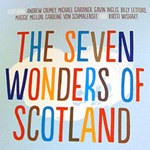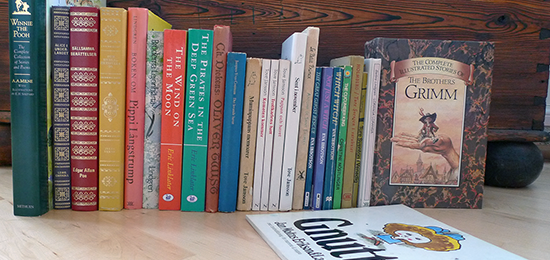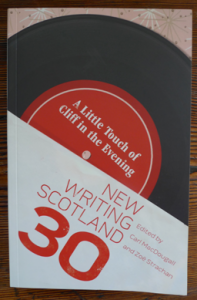I saw part of this video on Facebook the other week. It’s fascinating. Take a few (12) minutes out to learn about paper marbling as done by Cockerell and Son in 1970. (Published by Bedforshire Archives.)
Category: Books
I write about Bellefleur for 100 Bookpeeps
Blythe Robertson started 100 Book Peeps as a way to raise money for his part of Bookfellas, a project that hopes to get men and boys reading for pleasure.
Bookpeep’s aim is to get 100 people to write something about their favourite book and raise money. It makes for very interesting reading: all kinds of books are in the list. My choice was Bellefleur by Joyce Carol Oats which I first read as a teenager. I’ve still not read anything quite like it. Read the Book Peeps post.
Not long now! New Writing Scotland 34
It has a title (what a title!) and cover art. The stories have been edited and proofed, the printer is standing by. New Writing Scotland 34 – Talking About Lobsters – should be in the shops from August 1st. I can’t wait for my writer’s copy.

Getting ready for the Edinburgh International Book Festival
Last year, I spent more time in the book shop than I did at the actual book festival. I can’t remember what happened to keep me away, but this year, I to play it differently. I didn’t hang on the phone and book hundreds of pounds of tickets but am taking a more leisurely approach. The first tickets I booked were not just for me but also a gift to my father-in-law.
My father-in-law and I have bonded over books. We don’t read all the same writers, but we both read quite a lot. After he told me about Benedict Jacka and lent me a book by him he’d enjoyed, I set out to introduce him to more urban fantasy/crime. My first step was to buy him three of Ben Aaronovitch’s Peter Grant books.
I’m a fan of Peter Grant. I took to him, and the people around him, immediately and enjoy spending time in his universe. I’m delighted to say that my father-in-law does too. He’s re-read the books at least once and is looking forward to the next one with some impatience.
He also reads Jim Butcher and we’ve had interesting conversations about the differences between the American way of telling a story and the British way. What makes one set of characters human and endearing and the other occasionally irritating? (We have other series to use for the comparison too: we’re getting erudite on this genre, Jim and I.)
So the tickets I got for the book festival? Ben Aaronovitch talking about writing a series. We’re looking forward to it and I expect we’ll have a grand evening.
Making books, then and now
Peggy Hughes posted this rather lovely film on how book were made a couple of weeks ago. Watch it and be amazed. (It’s 10 minutes long.)
(If the video doesn’t show above, if you’re running an ad blocker, for example, you can find it on YouTube.)
I did my own search to find a video on how books are made now. I expected to find something that took out most of the steps in the above that amazed me and made the process look safer, but still somewhat magical. I failed: most of the videos I found were marketing materials for large book printers and don’t cover anything before the moment of printing. The one below starts with the printed page and covers perfect binding – it’s not as fabulous as the one above but makes up for that by being under three minutes long.
(Or go to YouTube to watch it there.)
And as a bonus, here’s how Random house do their thing, from editing, to covers, to marketing. This is also close to 10 minutes long.
Favourite childhood books for World Book Day
Today is World Book Day (in the UK). Roy Gill included me in a chain of posts on favourite childhood books. These are the books that fascinated me as a child, and still influence the types of stories that I want to write and read. How could I not share?
Continue Reading “Favourite childhood books for World Book Day”
The Next Big Thing: Salanntùr and The Seven Wonders of Scotland
The talented Lynsey May kindly asked me last week if I wanted to pick up the baton and share my Next Big Thing. Over the last few weeks, writers have written about what they’re doing next and asking other writers to do the same. The resulting blog posts make for inspiring reading! I couldn’t turn down a chance to brag a little, so here goes.
1. What’s the title of your latest story?
Salanntùr. It’s one of seven stories in a collection called The Seven Wonders of Scotland.
2. Where did the idea for the story come from?
Birlinn put out a call for submission for an anthology of stories about imaginary Scottish wonders that said something about Scotland as she is today, or what she might be tomorrow. I’d been reading an article about an idea for slowing global warming: kilometer-high salination towers floating around the Faroes. It was in part based on research done at the University of Edinburgh. I though “what if that worked? What if we’d been working towards that solution for decades – how would that affect Scotland, and what could it mean for the world?”
3. What genre does your story fall under?
Literary fiction.
4. What actors would you choose to play the part of your characters in a movie?
The main two characters are Janet, a journalist from Glasgow, and Arthur, a not so nutty professor. In my mind, Janet looks something like Fiona Bruce but she’s not an actress. Hm. Let’s pick Kelly Macdonald for that role, though she’s a little too young. Arthur is tall, tweed-clad, and ageing gracefully in the salty air of northern Scotland. I need someone distinguished who can make us believe him when he flips from warm to cold. John Hurt would be perfect.


See? Don’t they look great? Now imagine them wind-swept and covered in salt. (Images from Wikipedia.)
5. What is the one sentence synopsis of your story?
It’s Scotland’s greatest gift to the world – a kilometre high tower that will float around the world’s oceans to spray a thin mist of salt water into the air, reflecting sunlight out towards space, cooling the earth – but it is a controversial gift because of how the building of it affects the local environment.
 6. Will your story be self-published or represented by an agency?
6. Will your story be self-published or represented by an agency?
Neither. Salanntùr is part of an anthology, The Seven Wonders of Scotland, and launches at Blackwell’s Bookshop, in Edinburgh, 18:30 on November 27th. Come along! Kirsti Wishart, Gavin Inglis and I will read from our stories. Gerry Hassan, the editor, will be there too.
7. How long did it take you to write the first draft?
I should know that to the minute, but I don’t. I wrote the first draft in stages to get it in to review with my writer’s group. The first version they saw took maybe four hours to put together and was a magazine article and a long list of bullet points. (The one that said “Epiphany here” got a good laugh.) I think I spent another six or eight hours filling in the gaps before I had something that can be called a first draft. It was way too long so I spent some time whipping it into shape.
8. What other stories would you compare it to within your genre?
The format – split between the first-person article that the journalist writes after her visit to Sallantùr and a third-person account of her experiences there – feels well established but I can’t think of a particular story that I’ve read that uses it. Books often use that structure but then the introductions are proportionally shorter.
9. Who or what inspired you to write this story?
My friend Helen Jackson told me about Birlinn’s call – I wouldn’t have know anything about it if she hadn’t mentioned it. Then I played with different ideas. The salt spraying tower came to me quite quickly, but in its first incarnation, it was a bone-white, 150 meters tall, 2,000 year-old salt-spraying tower that rose from the middle of Loch Ness. Imagine that long valley, dusted in salt, sparkling dully in the sunshine: black water, white, white ground and a spire, straining towards the sky. It was a nice image, but rather too baroque for what I was trying to say.
10. What else about your story might pique a reader’s interest?
It has everything you might want in a story: strong characters, evocative environments and science. I’d like to visit Salanntùr, it’s an intersting place. It’s a pity it’s fictional.
Now, I’m passing the Next Big Thing baton on to Gavin Mcmenemy. Gavin’s was my first writer’s group (it was a small group) and writes great stories, often, but not always, with in the sci-fi genre. He has a story in the Diamond Light Source short story anthology Light Reading. The cover art is, in fact, an illustration for his story. So, what’s next? Take it away Gavin!
The Edinburgh International Book Festival: things to see and do
Last year, I went rather wild at the book festival. This year, I’m taking it easy. I’ve only booked events at the weekend or in the evening and I’m only doing one workshop. But what a workshop.
1-2-1 Writing Clinic
According to the program, the 1-2-1 Writing Clinic on Sunday 19th is for new writers who wants advice from professionals who have been through it all. To help the adviser, we’ll be asked to submit materials in advance. I’ve got 15 minutes with a publisher at 10:15 in the morning. I’ve got 15 minutes with Francis Bickmore, Editorial Director for Canongate Books. I’ve prepared my one-page CV and am choosing between a number of candidates for 500-word writing samples. 15 minutes isn’t long so to get the best out of my time, I’m thinking hard about the questions I want to ask and, of course, writing them down.
People to see
If the weather is good, Charlotte Square is quite a nice place to just hang out. You don’t have to have tickets for things to have a cup of tea, browse the book shop and do a bit of author spotting. (But don’t crowd the author’s yurt. It’s bad form.) The festival programme has all kinds of fun and I’m attending a couple of debates as well as author talks. Here are the events I’m particularly looking forward to:
- Sunday 12: Alasdair Gray. Always a joy. (And we’re in the same anthology now, so we’re almost pals, don’t you know.)
- Monday 13: Neil Gaiman & Chris Riddell on Coraline. One of my favourite authors, one of my favourite books.
- Friday 17: Nathan Englander & Etgar Keret on translation. As someone who writes in their second language, translation fascinates me.
- Monday 20: China Mieville. I’ve read his writing, now I’d like to hear the man speak.
- Monday 27: Ken MacLeod & Chris Becket on scary futuristic fictions. Ken’s an interesting speaker and I’m reading his Engines of Light trilogy at the moment so I’m really looking forward to this.
Things to do
Then there’s Unbound, the free event in the Spiegeltent. They offer all kinds of booky fun in a relaxed atmosphere and for no cost other than what you spend on drink. I’m hoping to go to:
- Wednesday 15: Magic Words – Illicit Ink at unbound! Fun times with magicians.
- Friday 17: Literary death-match. I’ve never been to one. It’s time to change that.
- Friday 24: Swimming and Flying, a talk by Mark Haddon.
- Monday 27: It will be all write on the night… To close the festival brave souls will finish an audience-lead story on the night. No time for edits here. R. A. Martens and George Anderson are part of the fun.
The contributor’s copy of New Writing Scotland 30 arrived in the mail this morning
Look at this, isn’t it pretty?
The table of content is rather attractive too. It’s got Lin Anderson, Alasdair Gray, Andrew Greig and Agnes Owens, as well as two of my writer’s group colleagues, R.A. Martens and Carol Farrelly. The stories I’ve read so far have been great. It’s an interesting mixture of poetry, short stories and even a comic.
The collection is available from Amazon now. (You can even read a bit of my story online: just click Look inside and then my name for a teaser page.)
The official launch is at Blackwells, from 18:00 on August 28th. Come along!
The joy of books – watch them dance!
Another book-related animation to gladden the heart. It is a perfect excuse for posting something and also announcing my resolution to buy most of my books from physical – maybe even local! – book shops this year. (Sorry Amazon, but they need my support.) Enjoy the dancing books.
The film was made by the owners of a bookshop in Toronto. I saw it on Twitter earlier today, where a Colossal post featuring it did the rounds. Can you imagine the amount of work it took to record it? All those books, organised, photographed and re-organised.

